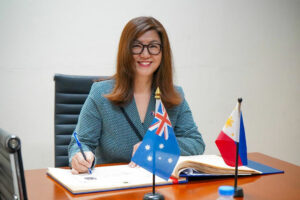Australia eyes more than P4B a year to support PHL mining, RE, infrastructure
AUSTRALIA plans to provide the Philippines more than P4 billion yearly until 2029 in official development assistance (ODA) to support mining, infrastructure, renewable energy (RE) and agriculture, as part of the country’s five-year development partnership plan with the Southeast Asian nation.

By John Victor D. Ordoñez, Reporter
AUSTRALIA plans to provide the Philippines more than P4 billion yearly until 2029 in official development assistance (ODA) to support mining, infrastructure, renewable energy (RE) and agriculture, as part of the country’s five-year development partnership plan with the Southeast Asian nation.
“We are talking about multiples of more than P4 billion per year of predominantly official development assistance in the Philippines to help [it] achieve good economic reforms,” Australian Ambassador to the Philippines Hae Kyong Yu told a news briefing in Makati after the launch of the program.
She said the Australian Embassy in Manila has brought in Australian mining tax experts to work with their Philippine counterparts as Congress deliberates on a measure that seeks to develop a new tax regime for the industry.
The embassy has also been encouraging players in the Australian mining industry to partner with mining companies in the Philippines on mining best practices.
Senators are set to continue floor debates on a proposal for a five-tier margin-based royalty rate system for the sector ranging from 1% to 5%, and a five-tier windfall profit tax system from 1% to 10%.
The House of Representatives approved its version of the measure in September last year.
Senate Bill No. 2826 seeks a royalty of 5% from large-scale miners inside mineral reservations based on gross output, while those outside reservations will follow the five-tier margin regime.
The government expects to generate P6.26 billion in yearly revenues from the mining tax regime, according to the Department of Finance.
The existing tax system for mining companies requires them to pay corporate income, excise, royalty, local business and real property taxes, as well as fees to indigenous communities.
President Ferdinand R. Marcos, Jr. on Wednesday urged the Senate to fast-track the measure’s approval.
Ms. Yu noted that about P3.6 billion of Australian’s planned annual funding assistance would be in the form of official development assistance.
In the past two decades, funding assistance from Australia to the Philippines has reached about P63 billion.
“We will support Philippine government agencies to implement key economic reforms, partner with the Philippines in key sectors including infrastructure, RE, telecommunications and digitization,” Australian Foreign Affairs and Trade Secretary Jan Adams said in a speech at the launch of the partnership.
Canberra will also work with Manila to improve its cash transfer and social protection programs for poor Filipinos. It will also partner with Philippine institutions to boost human capital and skill development programs to raise the employability of Philippine workers.
“These are sectors where Australia believes we have a comparative advantage… We’ll be looking to help develop your mining sector,” Ms. Yu said.
Two-way trade between the countries reached P378 billion last year, while more than 250 Australian companies employed 44,000 Filipinos.
Trade and investment between Canberra and Manila could grow by 10% this year, Luisa Rust, minister-counselor and senior trade and investment commissioner of the Australian Embassy, earlier told reporters.
“The development partnership plan builds on our countries’ close partnership, and sets out how we will pursue our shared development priorities so that together, we can shape a peaceful, stable and prosperous region,” Ms. Yu said.












